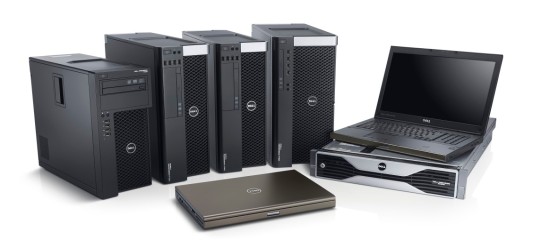23 April 2012: Last week I attended the Dell Precision Workstation announcement in San Francisco for their new line of Precision workstations meant for professionals with a need for high amounts of computation. Under embargo until today, I am now free to explore the details of the announcement with you.
If any of you were paying attention to my tweets of last week you may have seen my expectations for this line, even before I knew what the details were. I posited that the new products, following a long tradition of hardware announcements, we’re going to be faster, more expandable, and a better price performer. All of that is true, along with some other characteristics:
- More green
- Quieter – 8 thermal sensors in chassis control 8 fans.
- Reliable memory technology – alerts user to replace defective DIMM’s
- Smaller packaging
- Easier to work on
- Rack mountable
- Can store up to 8 hard drives internally
- Processor choice: multi socket or single socket (1 or 2 Xeon E5-2600 processors); each with up to 8 cores
- Max memory up to 512 GB
- Offers many times the performance for about the same cost
The four new systems T7600, T5600, T3600, and the T1560 all use the last Intel Xeon processors, and support both NVIDIA graphics cards along with NVIDIA’s Tesla boards with their amazing graphic CPU’s.
Maximum expandability is enormous and will form the basic choice of which system users will buy. By now the Dell website is updated with the specs. Go to www.dell.com for the details. The Intel spokesman stated that the T7600 is faster than the fastest supercomputer of only six years ago. Absolutely incredible!
I spent a fair amount of time at dinner the night before the meeting speaking with the industrial designers, who were very excited about the design, particularly the packaging and the ease with which users can access and upgrade the internals. On the T7600 and the T5600, the motherboard is now positioned away from the chassis so that the power cabling is all on one side and the electronic connections are on the other. Very nice. The entire power supply is an isolated unit that plugs directly into the chassis, thus it can swap out in seconds. A far cry from having to mess with the power plugs, as in the past.
Note that no power cables are on this side of the motherboard, which is now more towards the middle of the chassis.
Here is a look at the removable power supply, accessible from the rear of the unit.
Here is what the new towers look like (the ones on the left).
I generally don’t cover hardware announcements, but I made the exception in this case because these workstations are clearly aimed at the engineering and rendering/animation markets. The Dell Precision T1650, T3600, T5600 and T7600 (left to right in the above image) workstations will be available for purchase worldwide starting in May.
- The Dell Precision T7600 pricing starts at $2,149 USD
- The Dell Precision T5600 pricing starts at $1,879 USD
- The Dell Precision T3600 pricing starts at $1,099 USD
- The Dell Precision T1650 pricing will be announced in May
I expect that the T7600 reasonably configured will be in the $4000 range and could go much higher by adding up to three Nvidia boards (Quadro plus up to 2 Tesla GPU boards) that are now possible with its 600 watt power supply and high speed bus access directly to the Xeon processors. Nvidia’s GPU boards, called Tesla boards contain up to 448 cores. You can find out more at http://www.nvidia.com/object/personal-supercomputing.html.
Using the full capacity of the multi-core systems requires that the software be optimized for multi-processor architecture. In conversations with Nvidia representatives, they said that programs with have tight loops, and high compute requirements while processing minimal amounts of data are ideal candidates. FEA solvers and renderers are ideal for multi-threading. By the way, if you had a chance to see the movie Hugo, a huge part was rendered. I can hardly imagine the compute cycles required.
Takeaways:
If you are a power user, this is the way to go: truly super-computer performance delivered for workstation prices.
I tried very hard to get metrics on speed comparisons, but Dell (rightly so) claimed that it was so specific to the job being run, that they were unwilling to discuss numbers. With all of the standard benchmarks out there I am a little surprised. If any of my readers want to make available their experiences on the performance side I will be happy to publish meaningful results.
While I am a Mac fan, I have several PC workstations on site. I am salivating at the chance to get my hands on a properly equipped T7600. I expect many of you are as well.
I hope the software vendors will soon expand their capabilities to match this hardware power available. For you software vendors reading this, here are some things to think about:
- More industry specific software that needs minimal information to produce designs.
- Fully integrated analysis during design (like spell checkers)
- Turning well specified requirements into designs
- Better graphical PLM systems, with full automatic selection and rendering starting at even the most complex products
- Allowing users to work totally with 3D stereoscopic models
- And so on . . .
Disclosure: Dell paid for my travel expenses to and from the meeting and hotel accommodations and meals in San Francisco.


